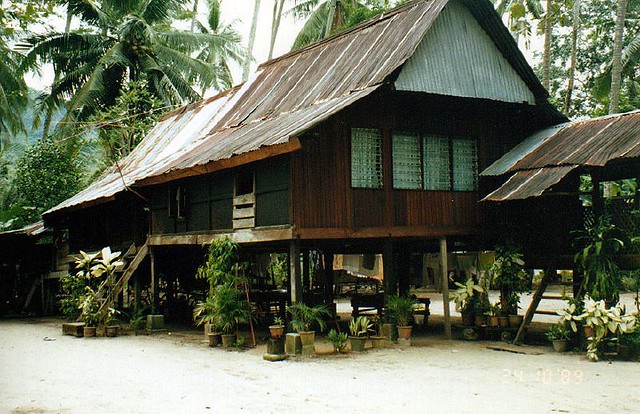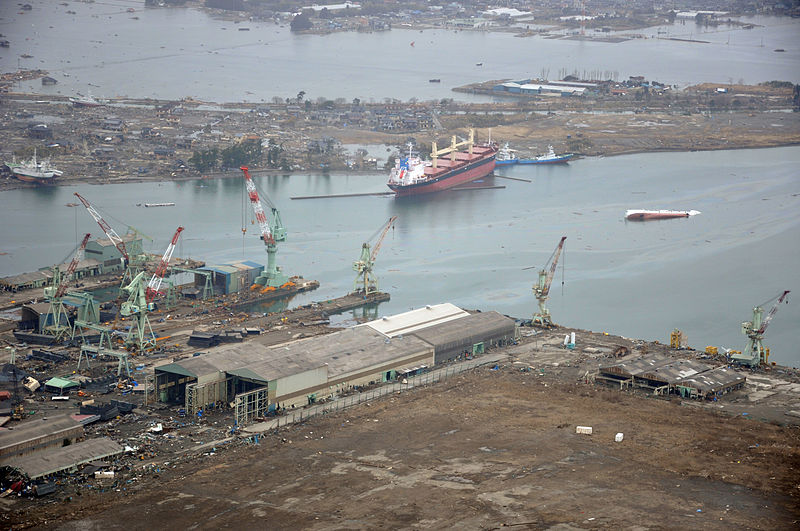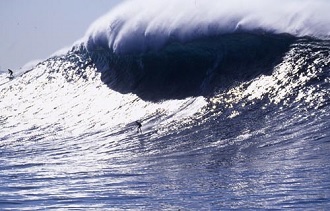Wave depth– The ocean waves you see at the beach are caused by wind and are therefore shallow. Deeper water further out the ocean moves slower and have little affect on the waves that hit shore. Their height and width are random, preventing the wave from gaining strength. Deep-sea waves caused by earthquakes, on the other hand, are incredibly deep and have uniform height and width. This gives them great strength when they hit shore, though the wave doesn’t rise very high at all in the deep ocean. The energy of a wave is proportional to the wave height squared, so a deeper wave has much more power. Ocean waves are longitudinal and transitional, which means they push objects in the water up and down as well as back and forward. The deeper you go, the less the water needs to move in order to transmit energy. This is why objects deeper in water aren’t pushed around as much by the wave. But otherwise ocean waves act a lot like simple sine waves, so I will represent them as such here. I will represent a deeper wave as a taller wave. |
Velocity= frequency x wavelength. Tsunamis have a frequency of up to once every two hours and a wavelength of up to 250 kilometers. These large numbers give them a velocity up to 500 mph. As they approach the shore the wave is forced to become much shallower. This decreases the velocity to only 50 mph. The wavelength then must drastically decrease as well, and the wave height as it appears from above water becomes much larger.
Shore steepness
Ocean waves topple over themselves as they approach shore because of the friction of the water against the beach floor. They become a mass of water pouring toward the shore which eventually slows because of gravity and friction. This wave break occurs far from shore with tsunamis because of their much larger wave depth. This mass of water may not be very tall when it reaches land, maybe a couple meters, but the overall energy of the wave turns it into a veritable river of water.

Steep coasts like the kind seen in Hawaii are different. The wave breaks close to shore with a very violent impact on the shore, though the water doesn’t move inland very far.

How to stop Tsunamis?
Stop the tsunami by: blocking, bouncing, deflecting, and canceling.
Troughs and Barriers

Troughs and walls both on shore and in the ocean will help absorb the force of the wave, and bounce part of that wave back. The wave will pound against the wall with great friction. Islands with barrier reefs are comparatively safe from tsunamis for this reason.

When it meets the underwater barrier the wave decreases velocity, decreases wavelength, and increases height when seen from above water. The wave could even break at the water surface. The wave then moves to deeper water with a weaker force, a smaller wave height.
Robust walls suspended from cables and floating near the surface of the ocean are much more effective because they also push the wave down toward the floor where it will lose more power from friction. Such devices could be ejected from underwater containers immediately after detected earthquakes, though this would be pretty expensive.

Troughs and barriers on the shore act like a sandcastles against oncoming ocean waves. They can slow down the water and redirect its flow, though they don’t act as effectively as ocean barriers would.
Onshore troughs and barriers are more effective when combined with offshore barriers. These offshore barriers can also deflect the wave sideways so it runs into itself and cancels part of itself away. The area down-shore of that barrier will have a much weaker wave hit it.

Underwater explosion
Waves that approach each other from opposite directions in phase eliminate forces of one another. An underwater explosion or some kind of other movement away from shore would create waves that pound into the tsunami wave and cancel some of its force. Unfortunately, it would have to be a large explosion or shifting object to make a significant difference.

After the water reaches shore there is little to be done. Most importantly, people need to get to high ground!
Channel the water
The edges of these channels can be shaped to push water toward the center of the channel. Curved edges can push the water away and back toward the channel.
Protect escape routes
Escape roads should be located around barrier that slow down water and away from water channels. These roads must not be straight lines that the water can use as channels. My illustration here is not the best because if water reaches these roads it will flow straight up them.

This example directs the water into channels, drainage creeks, where it flows safely inland. Tough barriers at the tips of the wedges, or maybe just berms, help divert water. Off-shore barriers help direct water away before it even reaches these wedges. Evacuation routes are safely protected inside these wedges.
Raise buildings

(john_worsley_uk– flickr/creative commons license)
Traditional houses in many South Asian countries are lifted up on stilts, though the intention has more to do with regional flooding and preventing animal infestations. Areas that rarely are flooded have little practical reason for stilt buildings unless it answers other design considerations. California apartments, for example, are sometimes placed above car garages. This conveniently keeps occupants safe from possible floods.
Debris between the coastline and the building will likely hit the structure with great force. Even heavy objects like cars and small houses can be carried by the water and turned into formidable battering rams. The stilt structures must therefore be very robust and tied down, and the water must somehow be diverted from the building with barriers. Liquefaction should also be considered and a robust foundation used.
Raised buildings should provide paths for the water to flow through. Apartments above car garages, for example, should have collapsable garage doors and back openings for the water to flow through.
Sanctuary structures
Some California towns have civic buildings that can act as gathering places for people who don’t have time to evacuate to high ground. These structures have large gathering spaces high up and are designed with a robust stilt structure. Residents must be well informed on where these locations are and given an evacuation route on how to quickly get there. Private office buildings and hotels should also serve this purpose. Coastal towns should keep an updated and well organized community plan for each resident and business.
Evacuees need know if they have time to seek higher ground or if they should flee to a sanctuary structure. A variety of sirens and a good plan of informing all residents are necessary. Each person needs to know their risk hazard and disaster relief plan.
Surviving After A Tsunami

Stores of food and disaster supplies must be kept in sanctuary structures. Good designs and building codes could prevent damage, but there isn’t too much practically to be done against an enormous surge of water. Early notification systems and a good evacuation strategy will prevent loss of life, but evacuees need shelter and basic supplies.
Could Japan have prevented nuclear meltdowns after the earthquakes and tsunamis had done their damage? Every city has hazardous materials that could cause longterm damage if hit by water. Fire could sweep the city and other disasters could result. Liquefaction could devastate neighborhoods that aren’t even touched by the wave. Historic landmarks and transit methods could have a profound social impact if destroyed. Perceived indifference for suffering, as was the case with Katrina, could have long-lasting social effects.
Inform the public
The sheer ignorance in the media during the 2011 Japan catastrophe illustrated how far we have to go. These important design steps will not be implemented until the public demands it, and right now the public isn’t even aware. News anchors didn’t even attempt to explain tsunamis and deferred to experts. Yet these “experts” didn’t even know what they were talking about. One government expert on CNN claimed tsunamis sweep across the land at 500 mph, unaware of the decrease in velocity that occurs as it approaches land.
The physics behind tsunamis isn’t really that hard, and the methods for dealing with it should be easy for anyone that has played in sand at the beach.



